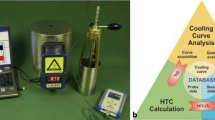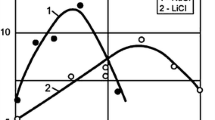Abstract
Immersion quenching is the most widely used quenching technique today and is usually one of the last steps in heat treat processing. Improper hardening to incorrect cooling is generally a great loss and causes a great percentage of manufacturing costs. To avoid a failure in cooling, researchers are committed to describing the cooling effect as precisely as possible.
The cooling of immersion cooled workpieces or probes is generally characterized by the process of wetting. Evaporable fluids exhibit the three well known stages of cooling: vapor blanket stage, boiling stage, and convective heat transfer. Therefore cooling behavior is influenced by a wide variety and depends on a number of parameters, that is, type of quenchant used, bath temperature, rate of agitation, and the physical and chemical properties of the quenched parts.
Environmental pollution has caused the search for new products in har dening and shock cooling of steels. The use of soybean oils as quenching fluids is new, and compared with standard mineral oils, there are many advantages mainly concerning the environment and the health of workers.
Similar content being viewed by others
References
N. Jones, Managing Used Oil, Lubes ‘n’ Greases, Vol 2 (No. 6), 1996, p 20–21
M.M. Mustokoff and J.E. Baylinson, No Case is Too Small, Hydraulics & Pneumatics, Feb 1995, p 35–37
H.F. Eichenberger, “Biodegradable Hydraulic Lubricant—An Overview of Current Developments in Central Europe,” SAE Technical Paper Series, Paper No. 910962, 1991
J. Meni, “Selection of an Environmentally Friendly Hydraulic Fluid for Use in Turf Equipment,” SAE Technical Paper Series, Paper No. 941759, 1994
S. Ohkawa, Rough Road Ahead for Construction Machinery Lubes, Lubes ‘n’ Greases, Vol 1 (No. 2), p 20–23
H. Fischer, “Environmetal Labeling in German Award Criteria for Hydraulic Fluids,” SAE Technical Paper Series, Paper No. 941078, 1994
R.J. Brennan and C.H. Faulkner, A New Quenching Alternative, Second Int. Conf. on Quenching and Control of Distortion, G.E. Totten, M.A.H. Howes, S. Sjostrom, and K. Funatani, Ed., ASM International, 1996, p 423–428
L.A.T. Honary, Performance of Vegetable Oils as a Heat Treat Quenchant, Second Int. Conf. on Quenching and Control of Distortion, G.E. Totten, M.A.H. Howes, S. Sjostrom, and K. Funatani, Ed., ASM International, 1996, p 595–605
L. Lazzeri, F. de Mattei, F. Bucelli, and S. Palmieri, Crambe Oil—A Potential New Hydraulic Oil and Quenchant, Ind. Lubr. Tribol., Vol 49 (No. 2), p 71–77
M. Tagaya and I. Tamura, “Studies on the Quenching Media 3rd Report. The Cooling Ability of Oils,” Technology Report, Osaka University, Vol 4, 1954, p 305–319
M. Tagaya and I. Tamura, “On the Deterioration of Quenching Oils,” Technology Report, Osaka University, Vol 7, 1957, p 403–424
H.M. Tensi, Wetting Kinematics, Theory and Technology of Quenching, B. Liscic, H.M. Tensi, and W. Luthy, Ed., Springer-Verlag, 1991, p 93–116
T. Künzel, “Einfluß der Wiederbenetzung auf die allotrope Modifikationsänderung tauchgekühlter Metallkörper,” Dr. -Ing. dissertation, Fak. f. Maschinenwesen der TU München, 1986, 138 Seiten
H.M. Tensi, T. Künzel und P. Stitzelberger, Benetzungskinetik als wichtige Kenngröße für die Härtung beim Tauchkühlen, HTM, Vol 42 (No. 3), 1987, p 125–131
H.M. Tensi and P. Stitzelberger-Jakob, Evaluation of Apparatus for Assessing Effect of Forced Convection on Quenching Characteristics, Mater. Sci. Technol., Vol 5, 1989, p 718–724
H.M. Tensi, A. Stich, and G.E. Totten, Fundamentals of Quenching, Met. Heat Treat., March/April 1995, p 20–28
H.M. Tensi, Methods and Standards for Laboratory Test of Liquid Quenchants, Theory and Technology of Quenching, B. Liscic, H.M. Tensi, and W. Luthy, Ed., Springer-Verlag, 1991, p 208–219
G.E. Totten, G.M. Webster, H.M. Tensi, and B. Liscic, Quenching Fundamentals—Standard for Cooling Curve Analyses, Adv. Mater. Process., Vol 151 (No. 6), 1997, p 6800–6822
H.M. Tensi and E. Steffen, Measuring the Quenching Effects of Liquid Hardening Agents on the Basis of Synthetics, Steel Res., Verlag Stahleisen, Vol 56 (No. 9), 1956, p 489–495
L.A.T. Honary, Vegetable-Based Hydraulic Oils, Handbook of Hydraulic Fluid Technology, G.E. Totten, Ed., Marcel Dekker Inc., New York, 1998
D.R. Erikson, E.H. Pryde, O.L. Mounts, and R.A. Falb, Handbook of Soy Oil Processing and Utilization, American Soybean Association, Champaign, IL, 1985
A. Stich and H.M. Tensi, Wärmeübertragung und Temperaturverteilung mit Bebnetzungsablauf beim Tauchkühlen, HTM, Vol 50, 1985, p 31–35
V.E. Loshkaroev, H.M. Tensi, H. Gese, and A. Stich, Calculation of Temperature and Heat Flux in Quenched Cylinders for Different Wetting Processes, Steel Res., Vol 65 (No. 9), 1994, p 390–395
Author information
Authors and Affiliations
Rights and permissions
About this article
Cite this article
Totten, G.E., Tensi, H.M. & Lainer, K. Performance of vegetable oils as a cooling medium in comparison to a standard mineral oil. J. of Materi Eng and Perform 8, 409–416 (1999). https://doi.org/10.1361/105994999770346693
Received:
Revised:
Published:
Issue Date:
DOI: https://doi.org/10.1361/105994999770346693




